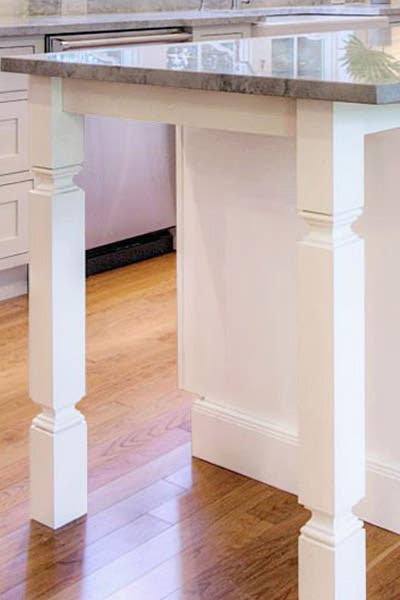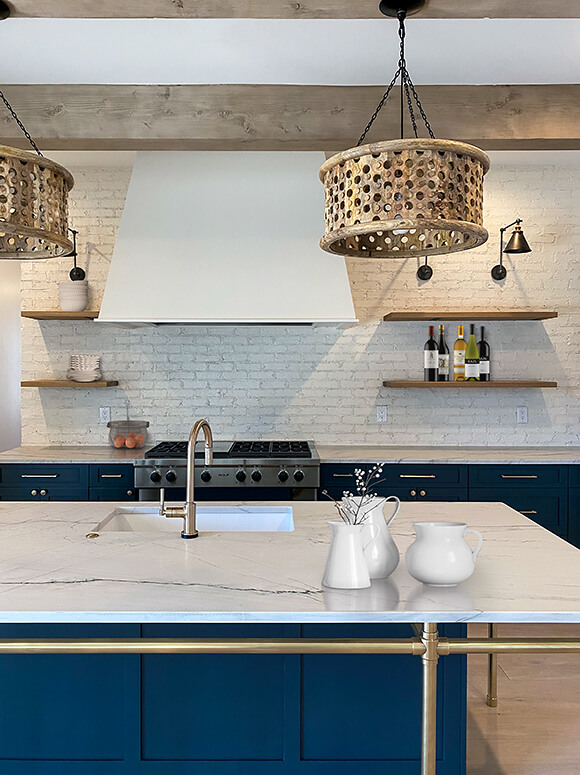Secret Considerations for Finding the Ideal Legs For Cooking Area Island for Your Style
When choosing the suitable legs for your kitchen area island, several vital factors to consider come into play that can considerably influence both performance and appearances. The choice of material, design, and height should line up with your total kitchen layout to make sure a harmonious appearance. Additionally, security and maintenance needs are critical for long-lasting usage and ease of treatment. Understanding these factors can improve your cooking area's functionality and aesthetic appeal, however the subtleties of each consideration can often be ignored. What effects might these options have on your cooking area's overall ambience?
Determine Your Design Choice
Establishing your style preference is vital when picking the ideal legs for your kitchen area island. The legs of your kitchen island not only serve a practical function however likewise contribute significantly to the overall aesthetic of the space. Recognizing your layout style-- be it contemporary, rustic, typical, or industrial-- is important.
For a modern kitchen area, consider smooth, minimalistic legs that complement tidy lines and open rooms. On the other hand, a rustic setup might gain from even more robust, farmhouse-style legs made of reclaimed materials. Typical cooking areas commonly prefer turned or ornate legs, which can include a touch of sophistication and elegance. Meanwhile, a commercial visual might call for steel legs that highlight a raw, incomplete appearance.
Additionally, consider the height and proportion of the legs in connection to the island's surface. Eventually, your design choice will certainly affect not just the option of legs yet also the overall harmony of your kitchen's style.
Select the Right Material
Picking the right material for your kitchen island legs is critical in making sure both toughness and visual allure. Numerous products supply distinctive benefits, and the option usually mirrors your layout choices and useful needs.
Timber is a prominent option, supplying warmth and flexibility. It can be discolored or painted to match your cooking area decor, making it versatile to numerous designs, from rustic to contemporary. Nevertheless, wood might need routine maintenance to preserve its look and honesty.

If you look for a distinct touch, take into consideration acrylic or glass materials. They can develop an illusion of area and agility in your kitchen, making them an exceptional choice for smaller sized areas - Legs For Kitchen Island. These options may need cautious handling and upkeep to avoid scratches.
Inevitably, the material you choose should line up with your cooking area's total design, making sure that the legs offer both decorative and practical functions.
Take Into Consideration Height and Percentages
When designing a kitchen island, height and percentages play a crucial duty in guaranteeing performance and comfort. The standard elevation for a cooking area island commonly varies from 36 to 42 inches, straightening with standard counter elevations or bar elevations, respectively. This dimension is important for balancing with bordering counter tops and stools, making it possible for convenience of use throughout meal preparation and social communications.
In addition, the island's percentages should match the general kitchen layout. A well-proportioned island needs to not bewilder the area; rather, it needs to produce a well balanced aesthetic. Discover More Think about the proportion between the island's width and size, ensuring it provides sufficient area without crowding the cooking area. A general guideline is to preserve a size of 24 to 48 inches, assisting in activity and ease of access.
Additionally, the height of the legs or base can influence the aesthetic charm and performance. Taller legs might provide an extra contemporary, ventilated feel, while much shorter ones can evoke a typical, grounded look. Inevitably, meticulously thinking about elevation and percentages will certainly lead to a cooking area island that is both visually attractive and functionally effective, boosting the overall style of the space.
Assess Stability and Resilience
A cooking area island's legs must not only enhance its elevation and proportions however additionally provide appropriate security and resilience to sustain day-to-day activities. The legs are necessary to the Homepage overall functionality of the island, as they bear the weight of the kitchen counter and any kind of extra lots, such as devices or cooking tasks.
When examining security, it is critical to consider the leg style and product. Durable metal or solid hardwood legs commonly use premium toughness contrasted to lighter products like crafted timber or plastic. Additionally, a wider base can enhance stability, reducing the risk of tipping or wobbling throughout usage.
Durability is equally vital; the legs should withstand wear and tear from day-to-day usage. Take into consideration surfaces that secure versus scrapes, dents, and moisture, especially in a kitchen area environment. Examine the top quality of building, such as joints and attachments, which can considerably impact the legs' long-term efficiency.
Eventually, buying well-crafted legs that focus on stability and sturdiness will ensure your cooking area island stays a trustworthy office for years ahead, improving your culinary experiences while keeping aesthetic allure.
Aspect in Maintenance and Treatment
Maintenance and treatment are vital considerations for making certain the longevity and efficiency of kitchen island legs. When picking legs, it is vital to evaluate the products used, as various options need differing levels of maintenance. As an example, wood legs may need routine refinishing or sealing to avoid moisture damages and scratches, while metal legs might require regular polishing to maintain their luster and avoid corrosion.
Moreover, the finish used to the legs can influence maintenance demands. A high-gloss finishing might be easier to clean however can reveal scratches and finger prints more easily than a matte surface. It is suggested to choose materials and finishes that match your lifestyle; for instance, if you regularly organize celebrations, opt for resilient materials that can endure damage.
Additionally, consider the cleaning process associated with maintaining these legs. Smooth surfaces typically need marginal initiative, while complex styles might collect dust and gunk, requiring more labor-intensive cleaning methods. Legs For Kitchen Island. Ultimately, considering the upkeep and treatment needed for your chosen kitchen island legs will not only enhance their visual allure however also ensure their functional honesty with time
Verdict
To conclude, choosing the optimal legs for a kitchen island demands mindful consideration of numerous elements, consisting of design style, product choice, stability, height, and upkeep. Each component index plays a crucial duty in making certain that the legs not only enhance the visual charm of the kitchen but additionally offer the necessary assistance and longevity for daily use. An educated decision will inevitably add to a functional and aesthetically pleasing cooking area environment.
The legs of your kitchen area island not only offer a functional function but likewise contribute substantially to the general visual of the area.Upkeep and care are essential considerations for making certain the durability and performance of kitchen island legs. Wooden legs might require regular refinishing or securing to avoid dampness damages and scrapes, while metal legs might require regular brightening to keep their shine and stop rust.
Eventually, factoring in the upkeep and care required for your selected cooking area island legs will not only boost their aesthetic charm however additionally ensure their practical honesty over time.
